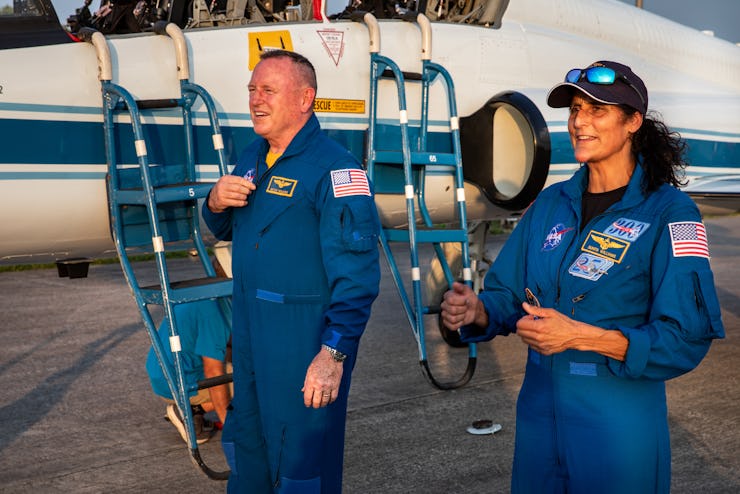How The Starliner Crew Have Kept Cool Heads In Quarantine
Astronauts sure know how to thrive in a quarantine — and come out ready on the other side.

For a long 26 days, the Boeing Starliner flight, what would be the first dissimilar contingency spacecraft for NASA’s Commercial Crew Program, has been put on pause. And while space fans attempted to prognosticate while they bit fingernails and engineers checked and rechecked helium and oxygen leaks, two crucial people waited a bit more intently then the rest. Astronauts Suni Williams and Butch Wilmore have been expectantly sitting in quarantine. But what, exactly, does that entail? As you might expect, a lot more than what we, one-time COVID quarantiners went through.
Astronauts have long been used to quarantines. The risks of not doing so are grave. Bring an infection up with you to space, and your crew members could become sick. That leaves the International Space Station vulnerable, as it requires constant upkeep and monitoring.
Williams and Wilmore are debuting a spacecraft that has yet to fly people before. They’ll need to perform manual tests onboard this vehicle. Developing symptoms in low-Earth orbit must be avoided at all costs.
NASA’s Boeing Crew Flight Test Commander Butch Wilmore (left) and Pilot Suni Williams (right) entered quarantine soon after this photo. Patience is truly one of the most important attributes of a modern-day astronaut.
When Starliner and the rocket it will fly on top of — United Launch Alliance’s Atlas V — revealed their malfunctioning parts on launch day and shortly thereafter, the astronaut duo entered what became a near month-long quarantine. It’s an extension of the weeks-long isolation they, and all astronauts, customarily do before any spaceflight.
“ ‘Don’t worry about us. We’re eating well. We’re exercising. ... We’re spending a little time talking to family members.’ ”
The astronauts “seem to be in good spirits,” Steve Stich, manager of NASA’s Commercial Crew Program, told reporters during a teleconference on May 24. He says his team has been communicating with them often. NASA has procedures in place to get them into different facilities without risking a break to their quarantine. During this period, they’ve spent more time in the Starliner simulator and practicing different failure cases.
“When I’ve talked to them, they’ll say, ‘Steve don’t worry about us. We’re eating well. We’re exercising. We’re listening to your meetings. We’re spending a little time talking to family members,” Stich said.
An Astronaut’s Guide To Mental Fitness In Quarantine
“It has been noted that astronauts face similar psychological challenges as submariners. The longer they are exposed to extreme isolation, the more likely it may impact their well-being,” according to NASA’s Kennedy Space Center.
To maintain their sanity, astronauts in quarantine keep to a routine. That “can help quite a bit,” Natacha Chough, clinical assistant professor and flight surgeon at the University of Texas Medical Branch, tells Inverse via email.
Their routines include exercise, “a popular activity to relieve stress,” Chough says. “Staying in regular contact with one’s support system — family and friends — remotely is also quite common. Sharing meals together prepared by the quarantine kitchen staff is also an important part of crew cohesion that begins pre-flight and continues in-flight.”
They also play games. “It depends on the crew, but games are among some of the activities available to help relieve stress and pass time,” Chough adds.
Suni Williams (middle) and Butch Wilmore (right) participated in a traditional game of cards inside the Neil A. Armstrong Operations and Checkout Building at NASA's Kennedy Space Center in Florida.
But it’s not just on their own shoulders. Astronauts have “an entire group of behavioral health and performance experts” to support the spacefarers-in-waiting and their families during the preflight time as needed.
What’s The Right Stuff During A Delay? Patience
Patience is non-negotiable as an astronaut. Once they ace the first nerve-wrecking flight of this never-previously-crewed spacecraft, their work only just begins. They’ll be flying in space for 25 hours before docking at the space station, their home away from home for about one week. Before docking, they’ll put Starliner through several manual tests.
The crew’s certification procedures as part of Starliner’s Crew Flight Test would herald in the expansion of NASA’s Commercial Crew Program. It was created to give a low-cost option to ferry astronauts to and from low-Earth orbit from American soil after the Space Shuttles retired in 2011. Starliner would join SpaceX’s Crew Dragon, providing “dissimilar redundancy”, aka a backup plan, if one company cannot reliably carry the astronauts. This ensures NASA has a way to maintain the space station continuously crewed with its astronauts. It also offers a safety net should something go wrong.
At the time of writing, the newest launch date for these two brave flyers is Saturday, June 1 at 12:25p.m. Eastern. If all goes well, they’ll dock with the orbiting laboratory the following day.